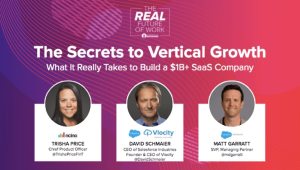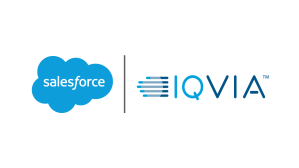The Secrets to Vertical Growth: How to Build a $1B+ SaaS Company, Featuring nCino, Vlocity and Salesforce Ventures



Trisha Price of nCino, David Schmaier of Vlocity, and Matt Garratt of Salesforce Ventures recently discussed the components of growth in vertical SaaS at SaaStr Enterprise. From strategies in recruitment and team building to sales tactics, these leaders shared the top tips for companies building a vertical SaaS business.
Vertical SaaS has grown significantly over the past few years. There have been a number of successful exits recently, including Vlocity and nCino. And, eight of the top 20 companies from last year’s Forbes Cloud 100 list — the definitive list of the top 100 private cloud companies in the world — were vertical software companies.
Salesforce Ventures invests in the world’s best enterprise cloud companies — both Vlocity and nCino are portfolio companies. Since 2009, Salesforce Ventures has invested across commerce, data, integration, marketing, sales, security, financial services, healthcare and more.
Companies in every industry have a digital transformation imperative, and Salesforce Ventures continues to see tremendous innovation and a number of companies being founded in the vertical SaaS space. Being vertically-focused allows companies to deliver seamless, industry-specific solutions, while speaking the language of the customer.
Let’s learn from these experts about why vertical SaaS has seen this growth, the phases of building a successful vertical SaaS company, and the importance of focusing on values, diversity and culture from day one.
Here are some selected excerpts from their recent panel discussion.
Matt: Vlocity and nCino are amazing businesses that grew to over $100 million dollars in revenue in five years. David, would you give us some background on what gave you the idea to start Vlocity?
David: I’ve been working in the front office space for 34 years, so I’ve been doing this a long time. And when I started, the worldwide market for what we now call CRM software was $50 million globally. Out of graduate school, I worked at a small company called Oracle in the 1980s, and I met a guy named Tom Siebel there. And I went off and co-founded a company called Siebel Systems with Tom and a few others. And another colleague I met named Marc Benioff from Oracle later went off to found Salesforce.
I became increasingly amazed by how big Salesforce was in the ecosystem. I was amazed by the AppExchange. It became clear to me that CRM was a huge opportunity. After walking around my first Dreamforce conference in 2013, I called up a few of my old friends from Oracle and Siebel, and we drew out the strategy for what became Vlocity.
Matt: Trisha, I’d love to get a bit more of your background and talk about the founding story of nCino.
Trisha: nCino is a little bit different in its background. We were actually built out of a bank called Live Oak Bank, and Live Oak Bank was founded in 2009. They had a need for a completely digital bank. At that time, it was pretty much unheard of to have branchless institutions. And so they started looking around for the right software to help digitize their processes and the cloud was important to them for scalability. So they started working on this concept of digital banking in the cloud, and from there very early on, we spun out and created nCino which is Spanish for Live Oak.
Since then we’ve scaled quite a bit. We have over 1,100 customers across the globe. We have offices in Tokyo, Sydney, Melbourne, Toronto, and Salt Lake City and then our headquarters here at the beach in Wilmington, North Carolina.
Matt: Let’s talk about the different phases of building a $1 billion vertical SaaS company. David, you talked a bit about the team and the founders. Can you talk about how you thought about hiring people who had SaaS and software experience, versus people that had industry specific experience?
David: I think the team is probably the most fundamental step, maybe even more important than the idea. I’m a big believer in getting the right people on the bus and then figuring out where you want to drive the bus to. I was able to call a few of my former colleagues, and the work we did to start the company was 24/7. As a startup, you need to be willing to do everything. You have to plug in the computers, you have to set up the network. You have to pay people, and you have to find office space.
I went through my Rolodex of top people that I knew from my prior networks of companies. Ultimately 10 of us banded together in a little low cost office to figure out how to build a bunch of industry verticals. And then, in a very key step, we formed a partnership with Salesforce.
Matt: Trisha, how did you start to hire and scale your team in Wilmington?
Trisha: It all comes down to the people. Lots of people have ideas but to make a company successful takes grit, and determination. It takes a certain attitude. It takes a relentless focus on customers. We absolutely have hired lots of folks with banking backgrounds. But the problem you get if you only focus on folks with a banking background is the “faster horses” problem. What I mean by faster horses is they know how to automate the processes that already exist at a bank, but that’s not really going to disrupt an industry. So, it’s not about faster horses, it’s about thinking outside the box. We searched for the best technical talent we could find, and people with the best attitudes.
Matt: David, can you talk about the initial product that you took to market and provide a framework for that?
David: The key for us was building not one industry cloud, but four. And then at Vlocity, we later added two more industry clouds and expanded to six. The secret to building more than one is reusing components, so that you don’t have six engines that do the same thing.
I couldn’t agree more with what Trisha said about how you have to have industry domain experts, and I had domain experts for each one of our industry teams. We immediately standardized on Salesforce, and we were amazed by how fast we were able to build on top of the platform. In the fall of 2014 at Dreamforce, we showed our four vertical apps, launched our company, and we were off to the races.
Matt: Can you also talk about the fundraising you did?
David: Our experience was a little unique — from prior experience we knew a lot of people in the industry. We wanted to partner with Salesforce, and if you’re going to build a company with Salesforce, who better to invest in it than Salesforce? Salesforce Ventures became our lead investor. And then, in our second round, there was room for a second investor. And so we went with Sutter Hill Ventures.
Matt: Trisha, can you talk more about your early approach to customer focus?
Trisha: It is about incredible customer focus in ensuring success. You have to have a services-focused approach, no matter how deep your product is and how much you’ve invested in your product.
Matt: And Trisha, how did you go about prioritizing and figuring out what was the next feature or product to add, to expand your product suite?
Trisha: There’s a tremendous amount of opportunity in banking globally, and our customers have an endless supply of ideas. So it does come down to prioritization. First of all, you always have to prioritize regulatory changes as well as customer pain. Getting it right is incredibly important and listening to your customers is critical. You also have to look at who else is in the same space.
When we think about the product, it’s a constant debate between adding teams to products we’ve already launched and adding new teams to new products. There is a balance between creating new products and keeping your current customers happy.
It is about incredible customer focus and ensuring success, especially in vertical software.
For more, please watch the panel where you’ll learn further about these five key takeaways:
- In the early days, focus on low churn and the ability to upsell instead of low gross margins and high services.
- Be prepared for a longer sales cycle, larger deals, and many opportunities to upsell.
- Hire a mix of people with technology and industry experience. You need people who can understand your customers’ pain points, and others who can innovate to solve them.
- Hire excellent people with the right attitude and give them the trust and support to do their best work.
- Be proactive about hiring a diverse workforce. Don’t expect them to come to you.

















